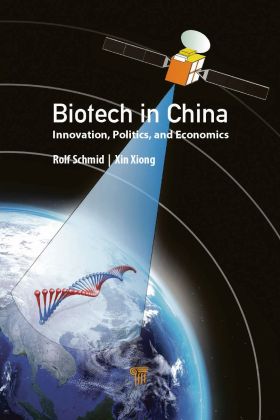Bioscience Trends in China’s New Five-Year Plan
Personalized and Telemedicine, Ecological Transformation, Brain Research and AI are Hot Topics
On 12. March 2021, the Chinese government published its „Draft 14th Five-Year Plan for the National Economic and Social Development of the People‘s Republic of China, and Vision 2035“.
During the preceding period of the 13th Five-Year Plan „135“ (2016–2020), China has made an impressive leap. Its gross domestic product increased from ¥74.640 trillion (€10.155 trillion) to ¥101.599 trillion (€12.910 trillion) and now accounts for about 15% of the world‘s economic output. For the first time, the average per-capita income exceeded $10,000 per year, and per-capita disposable rose by 40%, showing that China has become “a moderately prosperous society”.
Almost half of the population now lives in cities and has an average living space of 40 m2 per person. Public transport enables a high level of mobility, with high-speed trains covering already 38,000 km. Fiber-optic networks and the Beidou satellite system reach almost every inhabitant. At the end of 2021, over 70% of the global 5G network is located in China and enables rapid digital services in industry, commerce, public health and administration.
China’s R&D Landscape and Strategy
Investment in research and development (R&D) is surpassed only by the US. There have been major successes in human spaceflight, space probes and radio-astronomy, arctic and deep-sea exploration. The country has moved into a leading position in supercomputers and quantum communication. China now ranks first both in national patent applications and in international PCT applications, and second, behind the USA, in scientific publications.
The 14th Five-Year Plan “145” suggests that these dynamics are to be maintained and even surpassed. Quantitative targets have already been set for some areas. As in the previous planning period, high priority is given to modernizing the country and the economy through R&D. According to Chinese statistics, 92 million or 6.5% of the population have some scientific or technical education. According to the State Council Information Office, 5.1 million persons are employed in R&D (full-time equivalents), by far the highest number of any country in the world. Spending on R&D was 2.4% of GDP in 2020 and is expected to increase further and will include more basic research. The 14th Five-Year Plan sets as priorities and outstanding goals: quantum computing, integrated circuits, brain research and artificial intelligence (AI), genetics and biotechnology, clinical medicine, and technologies for space, earth, deep sea and polar exploration.
Three current hot spots of Chinese bioresearch are personalized and telemedicine, ecological transformation, and brain research and AI.
“China’s investment in research and development is surpassed only by the US.”
Personalized and Telemedicine
In urban areas, the quality of healthcare in China is no longer much different from Western industrialized countries, but China’s rural population is still undersupplied. Rural hospitals usually lack both well-trained medical staff and expensive equipment. Thus, examinations by MRI, CT, etc. often need to be performed in urban hospitals, often hundreds of kilometers away. Here, telemedicine made possible by China‘s rapidly advancing communication network offers some relief. Therefore, during “135”, over 1,000 urban hospitals of the highest class 3 have already assisted hospitals in rural areas with examinations (internet hospitals), and even with tele-guided instructions during surgery.
Service providers such as AliHealth or AnPing Good Doctor provide telemedicine services, which cover over 400 million registered users, 30,000 registered doctors and 1 million registered health care institutions. Users may not only book vaccination services or online emergency consultations, for which they can upload diagnostic images or test reports, but online consultation extends to diagnosis, consultation of more than one specialist, and a wide range of follow-up measures.
While the public health services cover the most frequent diseases, rare diseases are emerging as a new category, which, in a populous nation such as China, provide a rich ground for diagnosis and therapy. Thus, genomic medicine has become a key direction of medical research and includes cancer, where knowledge in its genomic patterns may help therapy.
Among over 200 DNA sequencing companies in China, the two major players are the Beijing Genomics Institute (BGI) in Shenzhen, and Genewiz in Suzhou. A third large center, the National Health Medical Big Data Center in Nanjing, is presently under construction.
BGI has published a study on the whole genomes of some 141,000 Chinese women, based on their NIFTY tests, and a “Chinese genome map” was built on the base of 597 healthy individuals from most areas of China — stimulated by the fact that in Western human genome programs the Chinese population is underrepresented. These efforts are meant to facilitate genetic testing and a personalized medicine and include “gene banks” such as the National Gene Bank in Shenzhen, co-financed by BGI.
Ecological Transformation
Aspects of China’s ecological transformation are air and water protection, green energy and greenhouse gas emissions, biodiversity, and sustainable chemical production.
Air and water protection: Like other nations, China experiences much air, water and soil pollution due to its rapid industrialization. Over the past decade, the government has initiated more and more rigorous rules to counteract these developments, such as a Real-Time Air Quality Network with over 1,500 stations in 400 cities. Since 2015, the burning of straw — a major cause of air pollution — is prohibited and provides, in theory, 700 million t of agricultural biomass as a carbon source for fermentation. Some 30% of China’s surface are either deserts or covered by sand and stones — a continuing source of dust pollution.
With the “Grain for Green” program initiated in 1999, China has paid 124 million farmers in 25 provinces to plant billions of trees on silting ground. Some 12,000 water monitoring sites across China reveal that only 35% of all probes provide water of good quality, but the 2015 “Water Pollution Prevention and Control Action Plan” ruled that, by 2020, 95% of all urban centralized drinking water facilities produced drinking water of at least class III quality, and the number of biological sewage treatment plants has grown to nearly 2,300. Still, emissions from agriculture result in algal blooms in China’s lakes and rivers, and seaweed farming leads to “green tides” along China’s 18,000 km coastline.
Green energy and greenhouse emissions: In 2019, 58% of China’s energy mix was based on coal, but the combined use of hydropower, nuclear and solar energy and wind power contributed already 29% (2020). Clean energy should supply at least 50% of the electricity in 2025, and China’s huge coal, oil and gas reserves are set to become the raw material sources of a gigantic petrochemical industry operating at high environmental standards, because China has vowed to peak CO2 emissions by 2030 and become carbon-neutral by 2060 at the latest. Presently, China which holds 19% of the global population accounts for 27% of global greenhouse gas emissions. The political agenda, however, points to a more and more stringent control of emissions, monitored by satellites, by China’s new EarthLab supercomputer and by comprehensive ecological research centers such as the new Shandong Energy Institute.
Biodiversity: Extending over many climate zones, China has a rich biodiversity, and a 2021 online catalogue of the Chinese Academy of Sciences (CAS) contains some 7 million records. Since 2017, 11 National Parks covering some 200,000 km2 are under mandatory and rigorous protection. Since 1994, the country participates in UN Biodiversity Conferences and implements rules and regulations for eco-environmental protection such as the Cartagena protocol. In October 2021, China was host to a UN Biodiversity Conference and prepared a “Kunming protocol” on extended biodiversity protection. Through its “Belt and Road initiative” (One Belt, One Road), China is providing technological guidance such as satellite monitoring and germplasm storage to developing regions in Asia, South America and Africa to protect these regions’ indigenous biodiversity.
Sustainable chemical production: China has become a global leader in the manufacture of bulk biotech products such as amino and other organic acids, vitamins, enzymes or biopolymers. More recently, techniques of a “synthetic biology” based on the integration of molecular genetics, bioinformatics and artificial intelligence have become a driving force for the development of plant- or microorganism-based “smart cells” which produce chemicals such as rubber monomers, antioxidants or drug intermediates from glucose or CO2 in high yields. Among the Chinese leaders in this field are the CAS Dalian Institute of Physical Chemics and the CAS Qingdao Institute of Energy and Bioprocess Technology.
Brain research and AI: A key feature of China’s brain research is the availability of monkey models (macaque and rhesus). China leads the world in the breeding and maintenance of inbred monkeys, e.g., at the Institute of Zoology of the CAS in Kunming, but also at the Chinese Institute of Brain Research, Beijing, and CAS Institute of Neuroscience, Shanghai. An interregional CAS Center for Excellence in Brain Science and Intelligence Technology (CEBSIT) puts a focus on brain anatomy (connectome), brain disorders, and brain-inspired computing methods and devices, based on such monkey models. Recently, the entire brain of a rhesus monkey was mapped at a resolution of 1×1×2.5 microns.
These studies will provide China with an opportunity to play a leading role in studying higher cognitive functions, such as empathy, consciousness, and language. The development of artificial intelligence (AI) will profit from these studies as the brain has much more complex connectivity patterns than present neural networks, shaped by learning over a long time and using extremely large data sets.
Rolf Schmid, Founder, Bio4Business, Stuttgart, Germany
Xin Xiong, Group Leader Biofunctionalized Surfaces, NMI Natural and Medical Sciences Institute, University of Tübingen, Reutlingen, Germany
_______________________________________________________
Biotech in China
The topics highlighted in this article are excerpts from the book “Biotech in China — Innovation, Politics and Economics”. The authors have composed this monograph based on thousands of Chinese publications, news, websites, and blogs. The book begins with brief accounts of China‘s geography, people, political and administrational structure, economy, finance, infrastructure related to science and technology, and educational system. It presents succinct accounts on biomedicine, diagnostics, agriculture, fermented food, bioindustry, and environmental biotechnology, with reference to government, industry, and academia. Finally, it predicts next steps in Chinese biotechnology for the national agenda and for the Belt and Road initiative, China‘s ambitious global development strategy.
Biotech in China — Innovation, Politics and Economics
Rolf Schmid and Xin Xiong
Jenny Stanford Publishing, July 2021
ISBN 978-981-4877-53-4 (hardcover)
ISBN 978-1-003-13193-9 (eBook)
_______________________________________________________
Contact
Bio4Business
Jagdweg 3
70569 Stuttgart
Germany
+49 711 3280468







